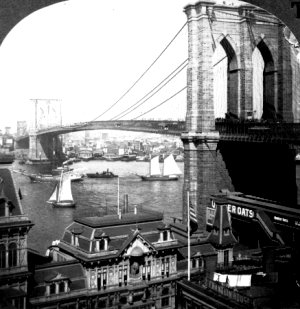Roebling's Other Bridge
Today, a story about bridges and kinship. The University of Houston's College of Engineering presents this series about the machines that make our civilization run, and the people whose ingenuity created them.
John Roebling designed the Brooklyn Bridge, but his foot was crushed near the site in 1869 -- just after construction began. He died of tetanus a month later, and his son, Washington, was left to build the bridge. Then Washington Roebling was paralyzed by the bends when he came up too many times from the high-pressure air in the subsurface foundations. Actually, Washington's wife, Emily Roebling, finally became the on-site director. She finished the bridge while she alone consulted with her crippled husband.
The Brooklyn Bridge opened in 1883, and it stands as a monument to many things: to the determination of the Roebling family, to beauty in design, to 19th-century ironwork, and especially to John Roebling, who figured out how to make modern suspension bridges.
Bridges had been suspended from iron chains for 2000 years. But the idea of spinning a wire cable right in place over a river -- adding a few strands in each pass -- was very new and very radical. It all began in 1841, when John Roebling, then a wire cable manufacturer, wrote an article on building bridges that way. A competitor first built such a bridge before Roebling did. But when Roebling built this kind of suspension bridge over the Allegheny River, he began a remarkable career of bridge-building.
John Roebling's next bridge spanned the Delaware River between New York and Pennsylvania. It was one of four bridges he built as part of the Delaware/Hudson canal system. It opened in 1847, 36 years before the Brooklyn Bridge, and it's still in service. This so-called Delaware Aqueduct Bridge emerges out of the trees on either side of the river. Its four sections span 535 feet. It's narrow by today's standards, but it's the only river-crossing for fifteen miles in either direction. Its massive piers support the delicate wound cables, and they're anchored deep in the earth on either side.
This bridge is, in fact, the oldest wound cable bridge that still survives intact. And it plays fitting counterpoint to Roebling's last crowning glory in Brooklyn.
Both bridges enjoy a kind of organic symbiosis with the world around them. The Brooklyn Bridge is so much a creature of the city. The aging Delaware Aqueduct Bridge, with its wooden planking and grass-grown moorings, seemed until recently to flow out of the wilderness and back into it. But today it's been restored into a vehicle-carrying bridge. These two bridges tell a tale of kinship. Kinship of concept and execution, kinship of father and son, and finally the all-important kinship of function and art.
I'm John Lienhard, at the University of Houston, where we're interested in the way inventive minds work.
(Theme music)
Vogel, R.M., Roebling's Delaware and Hudson Canal Aqueducts. Washington, D.C.: Smithsonian Institution Press, 1971.
Vogel, R.M., Building Brooklyn Bridge: The Design and Construction, 1867-1883. Washington, D.C.: Smithsonian Institution Press, 1983.
Vogel, R.M., Designing Brooklyn Bridge. Annals of the New York Academy of Sciences, Vol. 421, pp. 3-39.
I am most grateful to Allen Swerdlowe, an architect working out of New York City, for his advice. Swerdlowe did the restoration of the Delaware Aqueduct Bridge between 1983 and 1987 while working for the Beyer Blinder Belle Architectural Firm.

(Photo courtesy of Robert Vogel)
The Delaware Aqueduct

(Photo courtesy of Robert Vogel)
Cable Saddles for the Delaware Aqueduct

(Stereopticon image courtesy of Margaret Culbertson)
And Roebling's last and most famous work, The Brooklyn Bridge